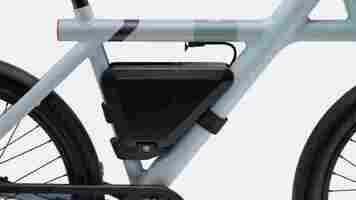VanMoof ebikes can now reach 155 miles of range with new PowerBanks
VanMoof makes some of the most stylish stealth ebikes around — we loved the S3 model in our review . But one of the most common complaints levied at the ebikes is that their battery is not user-removable.

This makes for two big particularly big annoyances. For one, you can’t leave the bike in a garage or storage room and charge the battery at home. For another, you can’t quickly swap the battery with an extra one for longer rides, should you decide to get out of town for a while or simply take an extra-long route.
VanMoof’s new $348 PowerBanks offer respite for both of these problems. The battery pack sits neatly in your bike frame’s triangle, adding an extra 378 Wh to the bike’s built-in 504 Wh battery for a total of 882 Wh — significantly larger than what you’ll find in most ebikes (let alone in stealthier designs like the Vanmoof). It weighs in at 6.2 lb (2.8kg).
VanMoof claims the battery pack provides an extra 28 – 62 miles (45 – 100 km) over the bikes’ initial 37 – 93 mile (60-150 km) range. Do the math and that means the company’s bikes now claim to go 65 miles in full power mode, and as far as a whopping 155 miles on a charge in the low-power economy mode.
That’s close to the range of the average electric vehicle — and you can still pedal when the battery runs out.
While $348 isn’t cheap, I’d say it’s at least reasonably priced in the world extra ebike batteries (let’s just say I’ve spent way more than that to get a second battery of similar capacity before). Granted, there are also ebikes that come with more battery capacity by default, like the Juiced CrossCurrent X , but that’s a heavier, less stealthy ebike.
To me, this is a gamechanger for Vanmoof’s bikes. As a heavier cyclist who likes to go on longer rides, I frequently get far less than a manufacturer’s claimed range — even when using low levels of pedal assist. Having the option to add a second battery gives me some peace of mind.
For those of us with range anxiety, the PowerBank could be the difference between choosing the VanMoof or opting for something else. And of course, you could always just buy a second power bank to increase the bike’s range even further; it’s a route I wish more companies would take.
The VanMoof PowerBank is available to order today and begins shipping in June.
We were told our cars would ‘talk’ to our smart homes — what happened?
When I first started writing about IoT in 2013, device makers promised a world where IoT would seamlessly facilitate a machine-to-machine connection between the smart gadgets in our lives, including our smart home.

Made possible by machine learning, our devices would become instinctual in the way they spoke to each other and responsive — with no human interaction.
One of the most significant examples touted at the time was car-to-smart home solutions. In this concept, our car and home would join forces to make our lives easier by learning our routines and increasing our comfort, being able to anticipate our needs before we know what we want.
Well, I think we’re still waiting for this magical time when devices are “smart” instead of simply “connected.”
What’s happened in the space, and why have so few promises failed to translate to action? Let’s explore this further.
We’ve been promised car-smart home automation but given little


2016 seemed to be a magical year for car automation and smart homes. SmartThings partnered with BMW to control smart homes through the SmartThings app. Volkswagen and LG partnered , and Ford joined forces with Amazon .
However, these partnerships have failed to progress into meaningful consumer products. Instead, carmakers pivoted their IoT interest deeper into their own connected car capabilities, leaving the home out of the equation.
And, sure, we can turn on our car with the Alexa voice command, but this is still connected , not smart. And we can do this already with our mobile phone s.
So what happened to the great integration?
In many respects, IoT is a victim of its own success. IoT devices are ubiquitous, and at least 37% of US households own at least one smart product – most commonly a TV.
The smart home market is competitive and one of the biggest problems is a lack of interoperability. Proprietary systems like Nest and Alexa don’t interoperate. This becomes more of a problem with the more devices you add.
For example, I look at my own phone and have three different apps to power my lights, excluding Alexa and Google.
This is very different from the promise of seamless IoT connectivity.
For example, what if my car could tell my home I was running late and trigger my connected cat toys to keep my cat company? Or identify that my car passed the pizza shop on the way home and preheat the oven? Imagine sensors in your car recognizing that you’re hot after a gym workout and sending a message to lower your home temperature automatically?
All of these would be things that wouldn’t require me issuing a voice command or clicking on an app — I’m sure you could think of examples in your own life too.
This is what you want… this is what you get
But instead, we’re left with a convoluted IoT ecosystem. Most devices don’t talk to each other inside the home — much less between the car and the house.
However, there are some wins. I see the biggest success, not by the smart home device makers or the automakers, but what I call the integrators.
Introducing EVEConnect
If you want your Tesla S to talk to your smart home, the EVE for Tesla app allows drivers and passengers to communicate directly with their smart home products. A comparable service is also available for Subaru drivers.
It’s the usual laundry list — home lighting, security locks, etc. — but what I like most is that the app integrates all of your connected home devices and brands into one convenient environment.
EVE for Tesla works with over 400+ smart home devices and smart home platforms Wink, SmartThings, Insteon, Home-Connect, Zapier, and Chamberlain. There are some shared functionalities available also with IFTTT .
Users can pre-set functions called “automations.” For example, pulling out of your driveway signals to close the garage door, lock the home’s exterior doors, and turn off the lights.
Is Mercedes Benz betting big on the smart home?
Beyond my laments, not all is lost. In October last year, Samsung partnered with Mercedes-Benz to help car owners control their smart homes via their cars.
Mercedes integrated the Samsung SmartThings platform into the Mercedes-Benz user experience (MBUX) voice assistant to let drivers remotely connect and control their SmartThings-powered smart gadgets.
Using natural language, such as “Hey Mercedes, did I forget to turn off my lights at home?” to “Hey Mercedes, is anyone at home?”, the MBUX Voice Assistant enables users to engage with their smart homes.
There are also retrofit options like Alarmom’s connected car platform that can adjust your thermostat automatically when you’re on your way home. It can also turn your outdoor lights on as you pull into the driveway and alert you to potential security mistakes like leaving your garage open or the front door unlocked.
Why does all this matter?
The time we spent in our homes due to COVID-19 makes us realize the value of a smart connected home. Further, we’re seeing a lot of interest in the idea of vehicle-to-home charging , where our electric vehicle generates energy for our homes.
All of this requires stellar interoperability. Fortunately, the Open Connectivity Foundation (OCF) work leaves me confident that good things are coming.
The OCF is establishing interoperability standards for connected devices – enabling them to discover and communicate with one another, regardless of manufacturer, operating system, chipset, or physical transport. Their efforts include the writing of the OCF Specification (with its corresponding OCF Security Framework) and product certification and testing.
It’s time to put that data monitoring and surveillance to good use
Further, there’s a more significant issue at stake. We have apps and devices that generate data. The data generates insights about our past and present actions. It also makes calculated predictions about the next thing we’re going to do.
How much of these insights actually serve us, and how much of the value simply goes to advertisers?
Our connected devices know all about us. I want them to put those instincts to good use, providing seamless operability, not merely offering me targeted advertising.
A handy list of EVs that won’t destroy your bank balance
This article was originally published by Martin Banks on Clean Fleet Report , a publication that gives its readers the information they need to move to cars and trucks with best fuel economy, including electric cars, fuel cells, plug-in hybrids, hybrids and advanced diesel and gasoline engines.

Affordable cars that move the green needle
Price is one of the most significant roadblocks to clean transportation. Tesla, arguably the most iconic electric automaker right now, recently raised the price of several models in the U.S. While new EVs come out all the time, many of them aren’t cheap.
Despite these trends, there are still affordable clean cars on the market today. The most famous examples may be expensive, but not everything is. Here are five budget options for sustainable transportation (with links to further Clean Fleet Report tests and news).
1. Mini Cooper SE
The 2020 Mini Cooper SE is the cheapest electric car available in the US right now. It comes in at an MSRP of $29,900, and that’s before the $7,500 federal EV tax credit. When that’s applied, buyers can get this car for less than $23,000. There are a variety of state and local incentives that can reduce that price even further.


Keep in mind that the Cooper SE has a relatively short range of 110 miles. If you don’t need to drive long distances, though, this remarkably affordable option could be ideal.
2. Nissan Leaf
When most people think of electric cars, Tesla is probably the first name to come to mind. While the Tesla Model 3 became the best-selling EV in 2020 , the Nissan Leaf held that distinction for years. That should come as no surprise, either, given the Leaf’s low price tag of $31,600.
The Leaf has a range of 149 miles, but the $38,200 Leaf Plus can go for 226. While the Leaf Plus isn’t exactly cheap, the EV tax credit and other incentives can make it even more affordable.
3. Hyundai Ioniq Electric
The Hyundai Ioniq Electric is only available in some states, but it offers a lot for your money. The $33,045 hatchback includes features like Bluetooth, heated seats and an 8.0-inch touch screen as standard. It also has a 170-mile range, one of the longest of similarly priced all-electric cars.
Like the Leaf, the Ioniq Electric has a pricier model that comes in at $38,615 before the tax credit. This model has the same range and power but comes with more features.
Hybrid cars
Hybrid cars are often more affordable than fully electric options, so you may want to consider one of these. They might also be easier to find, as virtually every major automaker produces at least one hybrid or plug-in hybrid model. If buyers can’t get their hands on a full-electric car, these are accessible, affordable alternatives.
Keep in mind, though, that hybrids may not be as green as they seem. The average hybrid car can emit around 28 tons of CO2 over its lifetime. That’s far less than gas and diesel vehicles, but still a considerable amount of emissions.
Electric bikes
Even the cheapest cars can still be pricey. Thankfully, buyers can get green transportation for less money than even a gas-powered vehicle. Electric bikes also produce no tailpipe emissions (since they have no tailpipe) and cost far less than any car.
Some electric bikes can go for more than 100 miles without pedaling. While they’re not as speedy as cars, they may go faster than you think, often reaching speeds of 20 mph or higher.
Sustainability can be affordable
The idea that green technologies are inherently expensive is somewhat of a misconception. As this list shows, even electric cars can be affordable. There are also even cheaper sustainable alternatives available.
Eco-conscious consumers don’t have to wait for green transportation to become cheaper. It’s already surprisingly affordable.
Do EVs excite your electrons? Do ebikes get your wheels spinning? Do self-driving cars get you all charged up?
Then you need the weekly SHIFT newsletter in your life. Click here to sign up .